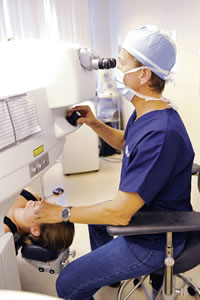
Lenses Inserted Into The Eye
October 05, 2011
By Dr. John Olkowski


Dr. John Olkowski
Eye Surgeon at Eyesight Hawaii
Where did your receive your schooling and training?
I attended undergrad and medical school at Georgetown University, and Ophthalmology residency at George Washington University in Washington, D.C. I then did an additional year of training, a cornea fellowship, specializing in corneal surgery at TuftsNew England Medical Center in Boston.
How long have you been practicing?
I have been practicing ophthalmology for more than 20 years. I worked at Kaiser Hawaii for almost 10 years and founded its laser vision correction program. In 1999, I founded EyeSight Hawaii Vision Institute, which has become one of Hawaii’s foremost centers for cataract, cornea transplant and LASIK surgery.
{embed=“elements/box_ad”}
Can you give an overview of the implant lens study you’re participating in?
The study uses a new device, called PresbyLens, to restore reading vision in patients over 45 years old who are wearing reading glasses. It is a microscopic implantable lens placed in the cornea, the clear front covering of the eye. To participate in the study, patients need to be using reading glasses, have had no previous eye surgery (no LASIK), no eye diseases and good distance vision without glasses. The preoperative screening takes about an hour and a half. It is a very thorough exam that people get for free. If patients qualify, they get the $3,000-$4,000 surgery for free and get paid several hundred dollars for follow-up visits.
What is the timeline of the study?
Phase 1 started in 2010, so the first 30 patients have finished a one year follow-up and are doing well. I entered at Phase 2, which has a total of 70 patients of which I did 14. Those 14 were out of a pool of more than 400 people who had inquired about the procedure. Ultimately, when the procedure is FDA approved, it is anticipated that we also will be able to perform this procedure on LASIK and cataract patients.

|
The PresbyLens produces a multifocal eye so that patients can see the full range of vision far, intermediate and near without glasses.
Only one eye is being operated on?
In this study, only the non-dominant eye is implanted with the PresbyLens. We’ll look at the results and we’ll see what patients think of their vision in that eye and perhaps in the future place
the PresbyLens in both eyes. Thus far, people have achieved great vision with this product and have been very happy with the results. Although it has not been necessary, the PresbyLens also can be removed from the eye.
Is Phase 2 a follow-up study or a whole new cohort?
All FDA studies are in three phases. So Phase 1 is a small pilot study of maybe 10-30 people, and then the next two phases are a bit larger and they expand the number of centers involved. EyeSight Hawaii is one of only seven centers in the country invited to participate in this study, the only site in Hawaii. In addition, my Maui office also will be one of the new Phase 3 centers.
{embed=“elements/google_ad336x280”}
When does Phase 3 of the study begin?
Phase 3 is coming up later this year. The study is recruiting another 300 patients. Anyone interested in participating can contact my office at 735-1935 or .(JavaScript must be enabled to view this email address).
Is this permanent or will eyes still degenerate as people get older?
Reading vision declines from about 45 to 65 years of age. This product should give patients good reading throughout that range.